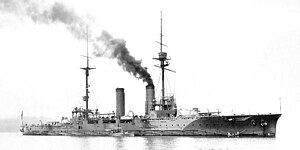Tsukuba-class cruiser
 The Japanese battlecruiser Tsukuba
| |
| Class overview | |
|---|---|
| Name | Tsukuba |
| Builders | Kure Naval Arsenal, Japan |
| Operators | |
| Planned | Six |
| Completed | Two |
| Cancelled | Four |
| Lost | One |
| General characteristics | |
| Type | battlecruiser |
| Displacement | 13,750 tons |
| Length | 134.11 m (440.0 ft) |
| Beam | 22.80 m (74.8 ft) |
| Draught | 7.95 m (26.1 ft) |
| Propulsion | Two Shaft Reciprocating VTE steam engine; 20 boilers, 20,500 shp (15,290 kW) |
| Speed | 20.5 knots (38 km/h) |
| Range | list error: <br /> list (help) 2000 tons coal; 160 tons oil 5,000 nautical miles (9,000 km) at 14 knots (26 km/h) |
| Complement | 876 |
| Armament | list error: mixed text and list (help)
|
| Armour | list error: mixed text and list (help)
|
The two Tsukuba class cruisers (筑波型 巡洋戦艦, Tsukuba-gata jun'yōsenkan) were battlecruisers operated by the Imperial Japanese Navy. They participated in numerous actions during the World War I.
Background
Construction of the Tsukuba class armoured cruisers was ordered under the 1904 Emergency Fleet Replenishment Budget of the Russo-Japanese War, spurred on by the unexpected loss of the Yashima to a naval mine in the early stages of the war. As the new class was the largest design yet attempted independently by Japanese naval shipyards, contemporary American military observers were surprised (and concerned) at the rapid pace of construction, and that Japan had learned to build such large and powerful warships so quickly. However, with rapid advances in naval technology and with increasing budget constraints on the Imperial Japanese Navy in the period immediately after the end of the Russo-Japanese War, the project was scaled back, and in the end, only Tsukuba and Ikoma were built out of what was intended to be a class of six vessels.
Design
The Tsukuba class cruisers were ordered and laid down before British Royal Navy's HMS Invincible. On the other hand, American Tennessee class cruiser of 1903 mounted 10" guns, which previously had been considered battleship guns (such as Russian Peresviet class battleship; USS Maine had been designed and built as a battleship, too). The design intent of Tsukuba class was to retain the speed and protection of the latest version armoured cruisers, but mounting battleship-caliber primary armament.
Armament
The main battery on the Tsukuba-class were four Type 41 12-inch 45 caliber naval guns, mounted in twin gun turrets to the fore and aft, along the centerline of the vessel. These were made by Japan Steel Works under licence from Armstrong Whitworth, and were the first large-caliber weapons manufactured in Japan. Secondary armament was provided by twelve Type 41 6 inch 40 caliber naval guns and twelve Type 41 4.7 inch 40 caliber naval guns.
Propulsion
Propulsion was by two vertical triple expansion steam reciprocating engines, two-shafts, with twenty boilers, yielding 20,500 shp (15,290 kW) design speed of 20.5 knots (38 km/h) and a range of 5,000 nautical miles (9,000 km) @ 14 knots (26 km/h). During speed trials in Hiroshima Bay prior to commissioning, Ikoma attained a top speed of 21.75 knots (40 km/h)
Ships in class
Commissioned from Kure Naval Arsenal in 1907, Tsukuba served patrol duty during World War I primarily in the Pacific Ocean and in Southeast Asia. On 14 January 1917, Tsukuba exploded while in port at Yokosuka, and sank with a loss of 305 men.
Ikoma circumnavigated the southern hemisphere of the globe soon after commissioning from Kure Naval Arsenal in 1908. Ikoma served patrol duty during World War I primarily in the Pacific Ocean and in Southeast Asia. Ikoma was a victim of the Washington Naval Agreement of 1923.
See also
![]() Media related to Tsukuba class cruiser at Wikimedia Commons
Media related to Tsukuba class cruiser at Wikimedia Commons
References
- Evans, David (1979). Kaigun: Strategy, Tactics, and Technology in the Imperial Japanese Navy, 1887-1941. US Naval Institute Press. ISBN 0-87021-192-7.
- Howarth, Stephen (1983). The Fighting Ships of the Rising Sun: The Drama of the Imperial Japanese Navy, 1895-1945. Atheneum. ISBN 0-689-11402-8.
- Jane, Fred T. The Imperial Japanese Navy. Thacker, Spink & Co (1904) ASIN: B00085LCZ4
- Jentsura, Hansgeorg (1976). Warships of the Imperial Japanese Navy, 1869-1945. Naval Institute Press. ISBN 0-87021-893-X.
- Schencking, J. Charles (2005). Making Waves: Politics, Propaganda, And The Emergence Of The Imperial Japanese Navy, 1868-1922. Stanford University Press. ISBN 0-8047-4977-9.
